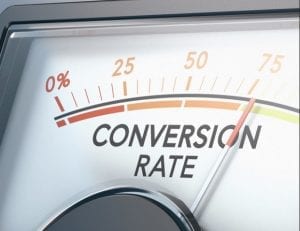When it comes to your conversion rate, ignorance isn’t bliss – it’s business suicide. Whether you’re selling a product, generating leads, or getting people to sign up for a newsletter, conversion rates are a key component of your overall business strategy, and they can make or break your success.
Generally speaking, the higher your conversion rate, the more profitable your company is. By contrast, low conversion rates can sink your ship. You can end up overpaying for prospects and customers – often to the point of putting yourself out of business.
The question now is, how do you increase your conversion rate? More on that in just a moment.

Table of Contents
What is a conversion rate?
Your conversion rate is calculated by taking the total number of visitors to your website and comparing it against those that completed a specific goal; with more specific calculation details down further. Depending on the nature of your business, this “goal” could be almost anything, but here are a few common types of conversion goals:
- Making a purchase
- Submitting a form
- Opting in to a newsletter
How to calculate your conversion rate?
The most common conversion rate formula requires you to divide the total number of goals completed in a given period by the total number of visitors to your website and multiply the result by 100%.
Conversion rate = (number of goals completed / number of visitors) * 100. If you have 100 visitors to your page and three complete a goal, you have a three percent conversion rate.
Fortunately, if you set up tracking correctly, Google Analytics and most other analytics solutions will automatically calculate your conversion rate and present you with an accurate figure right in their dashboard.
How to increase your conversion rate?
You’re probably paying to drive visitors to your site through paid ads or a good search engine optimization company (see our post on Forbes), and a higher conversion rate means a better return on your money or time spent. Additionally, improving your conversion rate allows you to provide a better experience to visitors who are expecting to gain value from your site, in the form of a product, service, or information. With that in mind, here are some tips to help you increase up your conversion rate.
Run A/B Tests
A/B or split testing is the strategy of identifying elements within a website that have the greatest potential to increase your conversion rate. For example, if you have two different offers for your product or service and you can’t decide which to use, you can perform an A/B test to see which one gets a better response.
Create two versions of your page (design “A” and design “B”), either with different designs, call-to-action, or messaging. Then use Google Optimize, or an A/B testing tool of your choice. These tools will send a portion of your traffic to page A, others to page B, and measure the difference in performance. The page with better performance is the one to consider turning on live to increase your conversion rate.
Eliminate Distractions
Visitors are easily distracted. According to Microsoft, humans have an attention span of eight seconds. This means you can’t afford to have unnecessary images or content on your website slowing down the speed of your page or delaying your customer understanding what you have to offer. Every element that is not crucial to emphasizing the offer that you want visitors to accept should be removed.
- Minimize links in your menu so your most important call-to-action stands out.
- Avoid suggesting that your website visitors check out your latest social media posts. Last thing you want is to send them off and down that rabbit hole, never to return.
Leverage social proof
Social proof is the concept that prospects are more likely to make a purchase with you if they’ve either been recommended by a mutual contact or previous customer, or they’ve been exposed to your social media content and built up some trust based on what you share. Here are some examples of social proof:
- Reviews and testimonials: These are shared to provide a reassuring and direct answer to visitors’ most pressing question: “Will I be satisfied with this purchase?”
- Customer count: It’s a powerful benchmark for prospective customers to see how many people trust your products or services.
- Industry endorsements: Endorsements from key personalities and thought leaders are worth their weight in gold.
- Trust seals: Especially for products and services where you require the submission of personal data, you want to communicate that visitors can trust you to manage their information with care.
Presence of social proof makes your company instantly more trustworthy because statements about how your product delivers a positive experience come unbiased from customers.
Conversion rate optimization is an endless journey. With some of the tips mentioned above, you should be able to see an uptick in conversions. It’s all about figuring what works and continually making improvements to maximize your results.
Originally published by Damon Burton on Forbes.
